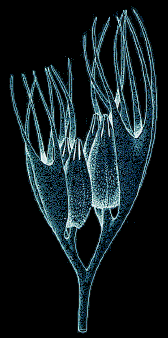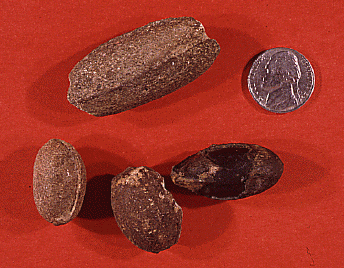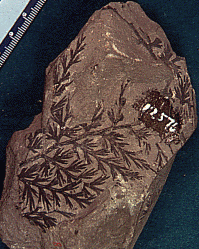



Seed plants: Fossil Record




 Today, the seed plants are some of the most important organisms on earth. Life on land
as we know it is shaped largely by the activities of seed plants. This large and important
group appeared early in the evolution of vascular plants, and throughout the
Late Paleozoic shared dominance of the land flora with
ferns,
lycophytes, and
sphenopsids.
Since the beginning of the Mesozoic, however, most trees and forests have consisted of
seed plants.
Today, the seed plants are some of the most important organisms on earth. Life on land
as we know it is shaped largely by the activities of seed plants. This large and important
group appeared early in the evolution of vascular plants, and throughout the
Late Paleozoic shared dominance of the land flora with
ferns,
lycophytes, and
sphenopsids.
Since the beginning of the Mesozoic, however, most trees and forests have consisted of
seed plants.
The oldest known seed plant is Elkinsia polymorpha, a "seed fern" from Late Devonian (Famennian) of West Virginia. Though the fossils consist only of small seed-bearing shoots, these fragments are quite well-preserved. This has allowed us to learn details about the evolutionary development of the seed. Another such fossil from about this time is Archaeosperma, also known only from fragments. At right is a diagram (modified from Stewart & Rothwell, 1993) of Archaeosperma arnoldii, showing four ovules surrounded by claw-like appendages.
The earliest seed plants produced their seeds along their branches without specialized structures, such as cones or flowers, unlike most living seed plants. The seeds were produced singly or in pairs, and were surrounded by a loose cupule. This small cup-like structure was lobed in the earliest seeds, producing a somewhat sheltered chamber at one end of the seed. Within this cupule, the seed was enclosed by a more tighly appressed tissue called the integument. The integument is a layer of tissue found in all seeds; it is produced by the parent plant, and develops into the seed coat. As the integument evolved to enclose the seed more tightly, an opening was left at one end, called the micropyle, which permitted pollen to enter and provide sperm to fertilize the egg cell. Both the integuments and cupule are believed to be the result of reduced and fused branches or leaves.
In later seed plants, a small pollen chamber appears just inside the micropyle. In modern cycads and conifers, this chamber exudes sticky fluids to aid in pollen capture, and as the fluid dries, it pulls the pollen inside the micropyle. This structure is preserved in detail in a number of recently discovered permineralized Devonian seeds. Besides preserving the pollen drop, minerals replaced the original tissues gradually, such that fine detail of the cell walls can be studied -- a few Permian seeds even have preserved embryos. Below you can see several Trigonocarpus from the Carboniferous.

Fossil Seeds: These are the permineralized seeds of a medullosan seed fern; such permineralized seeds are classified in the form genus Trigonocarpus. These particular fossils come from the Francis Creek Shale in Illinois, and are more than 300 million years old.

By the end of the Devonian, a variety of early seed plants collectively known as "lyginopterids" appeared. These include Sphenopteris, a plant with fern-like leaves, but which bore seeds and cupules. You can see a picture of these leaves at left. It is not clear whether Sphenopteris is a single group of closely related plants, or several with similar leaves.
The Carboniferous saw an increase in the number and kinds of seed plants. In the coal swamps of North America grew pteridosperms like Medullosa, a seed plant that resembles modern tree-ferns, but which bore seeds. Cordaites also grew in these swamps, and in a number of other habitats including ocean-edge environments similar to that of the modern mangrove. However, the cordaites are believed to be closer relatives of modern conifers. Both the medullosans and cordaites were small trees when compared to the great scale-trees which dominated these Late Paleozoic coal swamps. Seed plants were thus overshadowed in their early evolution by plants which did not produce seeds.
By the Westphalian (Late Carboniferous), the Voltziales first show up. These are believed to be the closest relatives of modern conifers, and in fact some paleobotanists classify them as conifers. By the Permian, the seed plants were beginning to produce large trees, and by the Triassic, all major groups of seedplants had appeared, except for the flowering plants.
For a chart of appearance dates for fossil seed plants, click here.
There is a nice exhibit on Plants of Mazon Creek at the Illinois State Museum. These were fossilized during the Pennsylvanian, and have been a rich source of information.
You might also try the Plant Fossils of West Virginia.

R. A. Gastaldo, ed. 1986. Land Plants: notes for a short course. Univ. of Tennessee Dept. of Geol. Sciences, Studies in Geology 15.
W. N. Stewart & G. W. Rothwell. 1993. Paleobotany and the Evolution of Plants. Cambridge Univ. Press, NY, USA. 521pp.
T. N. Taylor & E. L. Taylor. 1993. The Biology and Evolution of Fossil Plants. Prentice Hall, NJ, USA. 982pp.

